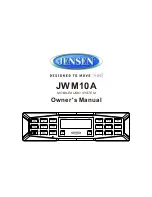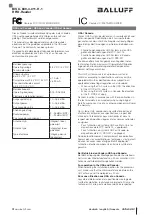
Epsilon
8
Set-Up Overview
OVERVIEW
This manual provides information about unpacking, locating, connecting, and using your Epsilon System. The sections
about System Configuration, Amplifiers and Other System Components, and Loudspeaker Placement come before the
Unpacking instructions. This is because we want you to have a clear view of the system as a whole before you begin to
think about the details of connecting and using your Epsilon System.
Most people prefer to minimize the handling and moving of large, heavy loudspeakers and amplifiers. When you have a
clear picture of the factors affecting the placement of these components, you may be able to make some essential
decisions about equipment placement and the effects on other furnishings before you unpack. This in turn may result in
less overall disruption and heavy lifting.
Please read this manual all the way through. Even if your dealer has done the heavy work and looked after the set-up
details, we believe the manual will provide you a better understanding of your Epsilon System and the opportunities it
gives you for truly superior sound reproduction.
INTRODUCTION
Your Epsilon loudspeakers are the result of lnfinity’s more than 25 years of research into the acoustics, operation and
design of high performance loudspeakers. The design goal for Epsilon was nothing less than to achieve the highest
overall level of performance, ever, from a single pair of loudspeaker enclosures. A corollary of that goal was to give
them a reasonable size and an attractive appearance, important factors in making them welcome in any listening room.
Each Epsilon loudspeaker employs unique Infinity technologies, including an active servo woofer system and high-
accuracy planar drivers, to deliver all of the hallmarks of high fidelity sound: Wide bandwidth, high acoustic power
output, uniform coverage, smooth frequency response and extremely low distortion.
These characteristics enable an Epsilon system to accurately reproduce the entire frequency spectrum, dynamic range
and sonic levels of the original performance. In short, Epsilon faithfully recreates the recorded performance in your
listening room.
The Epsilon System has three pieces: Two loudspeaker enclosures and one electronic Servo Control Unit (SCU). For
operation, the Epsilon system requires a separate component stereo preamplifier (or audio control unit) and:
Two stereo power amplifiers - or
Four mono power amplifiers - or
One stereo amp and two mono amps
The Epsilon System requires two power amplifier channels for each loudspeaker enclosure: One for the servo woofer
section and one for the mid/high frequency section containing the planar midrange and tweeter drivers.
Each Epsilon loudspeaker’s two sections are completely separate electrically, so that there is no danger in using any
amplifier combination, whether on separate or common chassis, to drive each Epsilon’s two sections or to drive both
Epsilons.
Each section of an Epsilon loudspeaker has a rated impedance of 4 Ohms. If you are using amplifiers that have output
transformers, such as tube-type amps, or solid-state amps that have output transformers, such as those built by
McIntosh Laboratories, connect the speaker cables to the “4 Ohm” outputs of the amplifiers.
The Epsilon Servo Control Unit goes between the preamplifier/control unit and the power amplifiers. Because the
woofer is an active servo type, an electronic feedback signal returns to the SCU from the loudspeaker via a special
cable supplied with each speaker.
Summary of Contents for IRS Epsilon
Page 1: ...Infinity Systems Inc 250 Crossways Park Dr Woodbury New York 11797 REV 0 03 2001...
Page 4: ...Epsilon 4 Quick Connect Guide for Balanced Inputs...
Page 5: ...Epsilon 5 Quick Connect Guide for Balanced Inputs...
Page 6: ...Epsilon 6 Epsilon Loudspeaker Quick Connect Guide for Unbalanced Inputs...
Page 7: ...Epsilon 7 Epsilon Loudspeaker Quick Connect Guide for Unbalanced Inputs...




































